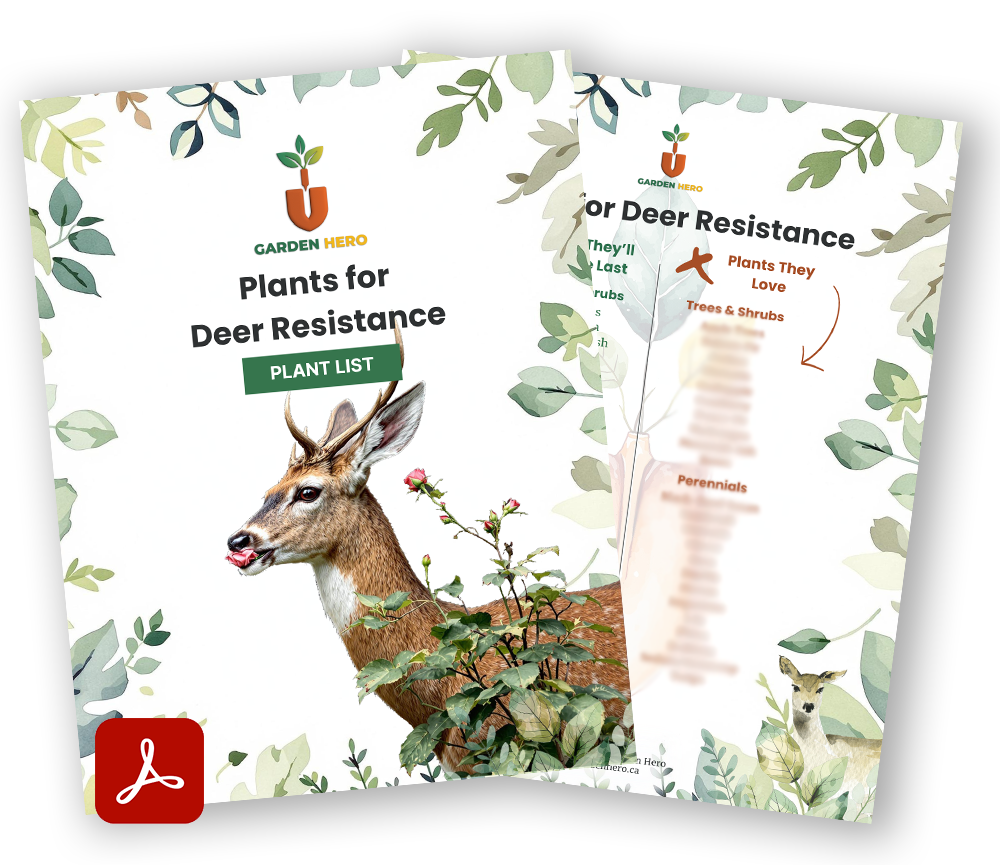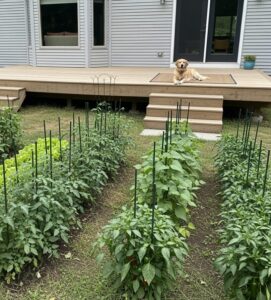Sometimes the best defense is a good offense – and when it comes to deer management, that means thinking like a landscape architect with a mission. Instead of constantly reacting to deer damage, what if you could design your garden to be naturally less appealing to these four-legged visitors from the start?
Deer resistant landscape design isn’t about creating an ugly, fortress-like yard. It’s about making smart choices that work with deer behavior rather than against it. By understanding what attracts deer and what makes them uncomfortable, you can create a beautiful garden that just happens to be far less tempting to browse. Think of it as psychological warfare, but with prettier results.
The beauty of this approach? Many of these strategies actually improve your garden’s overall design, functionality, and curb appeal while simultaneously making it less deer-friendly. It’s a win-win that saves you time, money, and frustration in the long run.
Design Strategies to Deter Deer
Plant Deer-Resistant Borders
 One of the best ways to create natural deer deterrent landscaping, is to using deer-resistant plants (the fuzzy, smelly, thorny, or toxic ones) around the perimeter of your garden or property to create a natural barrier. Deer are less likely to push through a hedge of juniper or lavender if they find it unappealing. For instance, a hedge of blue spruce or barberry not only provides year-round structure but also is prickly and blocks vision, which deer dislike. Likewise, interplanting pungent herbs among your roses or veggies can lend some protection – e.g., a ring of garlic and chives in a rose bed might help mask the rose scent that draws deer. The goal is to conceal or complicate access using plants deer ignore or generally avoid.
One of the best ways to create natural deer deterrent landscaping, is to using deer-resistant plants (the fuzzy, smelly, thorny, or toxic ones) around the perimeter of your garden or property to create a natural barrier. Deer are less likely to push through a hedge of juniper or lavender if they find it unappealing. For instance, a hedge of blue spruce or barberry not only provides year-round structure but also is prickly and blocks vision, which deer dislike. Likewise, interplanting pungent herbs among your roses or veggies can lend some protection – e.g., a ring of garlic and chives in a rose bed might help mask the rose scent that draws deer. The goal is to conceal or complicate access using plants deer ignore or generally avoid.
Deer resistant landscape design isn’t about creating an ugly, fortress-like yard. It’s about making smart choices that work with deer behavior rather than against it. By understanding what attracts deer and what makes them uncomfortable, you can create a beautiful garden that just happens to be far less tempting to browse. Think of it as psychological warfare, but with prettier results.
The beauty of this approach? Many of these strategies actually improve your garden’s overall design, functionality, and curb appeal while simultaneously making it less deer-friendly. It’s a win-win that saves you time, money, and frustration in the long run.

Ready to create your deer-resistant border?
Download our free Zone 2-4 Deer-Resistant Plant List to choose the perfect perimeter plants that deer naturally avoid while enhancing your garden’s beauty.
Eliminate Deer Hideouts & Attractants
Deer appreciate a comfy spot and an easy meal. If your yard has areas of tall, unmown grass or dense brush, deer may feel safe bedding down or loitering there. Keeping the lawn trimmed and underbrush thinned makes deer feel more exposed (they typically prefer to stay near cover). Also, remove any obvious buffets: If an old apple tree drops fruit, pick it up promptly. If you have a bird feeder, be aware spilled seed can attract deer. Compost piles should be fenced if they contain tasty scraps. By reducing these attractants, you reduce the incentives for deer to enter your space.
Garden Location Matters
If possible, site your vegetable garden or highly vulnerable plants close to your house or near human activity. Deer are naturally wary of human scent and will be more hesitant to approach areas that are near patios, dog kennels, or frequent traffic. Gardens right up by the home or in enclosed courtyards are less likely to be raided than those at the far end of the property bordering woods. Even having some wind chimes or leaving a bit of human scent (like worn clothing) near the garden at night can psychologically keep deer at bay, although these tricks are not foolproof.
Use Pets and “Deer Chasers”
 A dog in the yard can be an excellent deer deterrent. Deer seem to know when a property has dogs – the smell and occasional bark can dissuade casual deer visits. Obviously, one shouldn’t rely solely on this (and not everyone has a dog), but it’s a helpful layer if you do. Some people have had success with motion-activated devices that mimic predators beyond sprinklers or lights – for instance, a fake coyote decoy that moves, or even simply moving garden ornaments around so the environment looks different (deer notice changes and can be spooked by them). While these methods vary in success, they contribute to an environment where deer feel less comfortable.
A dog in the yard can be an excellent deer deterrent. Deer seem to know when a property has dogs – the smell and occasional bark can dissuade casual deer visits. Obviously, one shouldn’t rely solely on this (and not everyone has a dog), but it’s a helpful layer if you do. Some people have had success with motion-activated devices that mimic predators beyond sprinklers or lights – for instance, a fake coyote decoy that moves, or even simply moving garden ornaments around so the environment looks different (deer notice changes and can be spooked by them). While these methods vary in success, they contribute to an environment where deer feel less comfortable.
Use Pets and “Deer Chasers”
A dog in the yard can be an excellent deer deterrent. Deer seem to know when a property has dogs – the smell and occasional bark can dissuade casual deer visits.

Obviously, one shouldn’t rely solely on this (and not everyone has a dog), but it’s a helpful layer if you do. Some people have had success with motion-activated devices that mimic predators beyond sprinklers or lights – for instance, a fake coyote decoy that moves, or even simply moving garden ornaments around so the environment looks different (deer notice changes and can be spooked by them). While these methods vary in success, they contribute to an environment where deer feel less comfortable.
The Golden Rule of Deer Management
Don’t Feed the Deer, Ever. It’s worth repeating… do not feed deer intentionally, ever! Sometimes well-meaning individuals leave out corn or kitchen scraps for deer, especially in winter. This will only train the deer to treat your yard as a regular feeding station. Not only can feeding make the deer problem worse for you and your neighbors, but wildlife agencies warn that it’s bad for the deer’s health and can increase disease and car collisions. Let deer find natural foods elsewhere.
Design Principles That Work
Here’s how to design a garden to deter deer:
Create Visual Barriers: Deer are less likely to enter areas where they can’t see escape routes. Use strategic plantings, trellises, or garden structures to create visual obstacles that make deer feel trapped or uncertain.
Embrace the “Messy” Look Strategically: While you want to eliminate true deer hideouts, a slightly “wild” border area planted with deer-resistant natives can create a buffer zone that deer find less appealing than your manicured garden beds.
Think in Layers: Design your landscape in zones – deer-resistant plants on the perimeter, moderately appealing plants in the middle, and your most vulnerable treasures closest to the house where you can protect them more easily.
Seasonal Considerations
Spring Setup: Early in the season, before deer establish feeding patterns, is the perfect time to implement these landscape changes. Deer are creatures of habit – if they learn your yard isn’t a good hunting ground early on, they’re more likely to seek food elsewhere.
Winter Planning: Use the dormant season to plan and plant your deer-resistant borders. Many deer-resistant shrubs and perennials are best planted in fall or early spring anyway.
The Long Term Payoff
The beauty of preventative landscaping is that it gets more effective over time. As your deer-resistant plants mature and your design elements become established, your garden becomes increasingly less attractive to deer while becoming more beautiful and functional for you.
This approach requires patience – you won’t see overnight results like you might with a motion sprinkler. But after a full growing season of consistent application, many gardeners find their deer pressure significantly reduced. The deer simply learn that your property isn’t worth the effort and move on to easier targets.

Want More Zone 2-4 Garden Resources?
Join our email list for resources on other common garden pests, and proven strategies that work in challenging Zone 2-4 conditions.
Putting It All Together
Preventative landscaping works best when combined with other deterrent methods, especially in the beginning. Use repellent sprays on new plantings while they establish, add motion sensors in key areas, and maintain your landscape design consistently.
Remember, the goal isn’t to create a deer-proof fortress, but rather a garden that’s simply less appealing than your neighbors’ yards (sorry, neighbors!). By making thoughtful design choices that work with deer psychology rather than against it, you can create a beautiful, functional landscape that happens to be naturally deer-resistant.
The best part? Many of these strategies – like creating defined garden zones, maintaining tidy landscapes, and choosing appropriate plants for your conditions – are simply good gardening practices that make your outdoor space more enjoyable for everyone (except the deer, of course).
